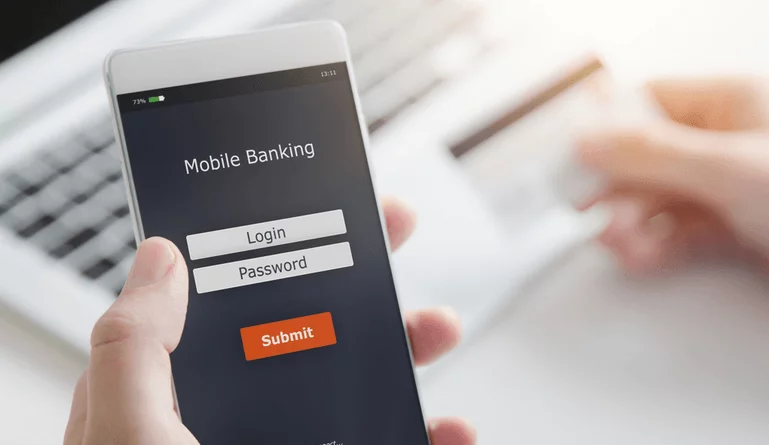Mobile banking is the act of making financial transactions on a mobile device. This can be as simple as a bank sending a fraud or usage activity alert to a client’s cellphone or as complex as a client paying an invoice to a vendor or sending money to family members who live abroad.
Mobile banking is a service provided by a bank or other financial institution that allows its customers to conduct financial transactions remotely using a mobile device such as a smartphone or tablet. Unlike internet banking, mobile banking typically uses an app that is provided by the financial institution for this purpose.
Mobile banking is available on a 24-hour basis and is often dependent on the availability of an internet or data connection to the mobile device.
History of Mobile Banking
Before the introduction and enablement of mobile web services in 1999, mobile banking was completed primarily through text or SMS and known as SMS banking. SMS was the most widespread form of sending messages when the use of mobile phones became more widespread in the late 1990s, and SMS banking used that format. SMS banking and mobile web were the most popular mobile banking products before 2010.
The arrival of WAP (Wireless Application Protocol) allowed many new mobile phones to access the internet and this brought new possibilities for banks, too. The first WAP banking services began in Norway in 1999 and soon spread to other countries. With the development of smartphones with iOS or Android operating systems, mobile banking applications began to evolve.
Clients were able to download the banking apps onto their smartphones with more sophisticated interfaces and improved transactional abilities. Till date, many financial institutions make use of both SMS and mobile applications to keep their clients informed of their account activities or to send out alerts regarding possible fraud, updates and maintenance of service provision.
( Also Read: Top 22 Mobile Banking Trends for 2021 )
How Does Mobile Banking Works?
As the world is evolving many people now carry out most of their work on their mobile phones because it is easy to access. Instead of going to the bank or queuing at the ATM stand to transfer funds, banks have made it easy for us to use their mobile banking app.
Although many people have these apps on their phones, not all fully know how it works. Mobile banking allows you to perform many of the same activities like online banking but using a smartphone or tablet, instead of a desktop computer.
However, simply accessing the bank’s website on a mobile device is not the only method of mobile banking, we can also use the mobile banking app by logging into the bank’s mobile website.
It is important to know that mobile banking is dependent on the availability of an internet or data connection to the mobile device. The mobile banking facility works over multiple platforms, with the most basic use of technology for mobile banking being the SMS service.
The Importance of Mobile Banking
As a result of the current pandemic, people are able to recognize and value mobile banking because of its many benefits. As we may have noticed, the pandemic has hindered us from so many activities, which is why most people now make use of Mobile banking app for easy access to their accounts.
One of the most significant benefits of mobile banking is that it is almost always available. You can equally carry out pretty much any financial transaction from your app.
You can transfer from one account to another and even transfer money abroad. Also, you don’t need to think about how secured your money is. Big thanks to multi-factor authentication (MFA), banks can link your account with your mobile device so that you are alerted when someone else is trying to log in.
With these above benefits, it is obvious that mobile banking is convenient and safe to use. You can log in to your account from your phone and access it wherever, and more importantly, whenever you need to.
Different Types of Mobile Banking Services
-
Account information access
Account information access allows users to view their balances and statements by requesting a mini account statement, review transactional and account history, keep track of their term deposits, review and view loan or card statements, access investment statements, and management of insurance policies.
-
Transactions
This type of mobile banking service typically includes obtaining account balances and a list of the latest transactions, electronic bill payments, remote check deposits, and P2P payments.
-
Investments
Investment management services enable clients to manage their portfolios or get a real-time view of their investment portfolios.
-
Support services
Support services enable clients to check on the status of their requests for loan or credit facilities, lodge a complaint, follow up on their card requests and locate the closest ATMs to their location.
-
Content and news
Content services provide news related to finance and the latest offers by your bank or financial institution.
Advantages of Mobile Banking
Mobile banking has proven to be one of the easiest-to-use and most beneficial platforms ever created. It offers a tremendous amount of advantages, below are four of them.
-
Convenience
It has been proven that people spend as much as 80% of their time on their mobile phones. This shows how comfortable most people are with their devices. Hence, we can always access our mobile banking app at the convenience of our homes, offices, and every other place.
-
Ease of access
Before the introduction of mobile banking, all financial transactions have to be carried out in the bank. Sometimes, people get very disappointed when they arrive at the bank after the closing hour.
But with mobile banking, we do not have to make the long trip to the bank for a simple transfer or wait till the next day to make a complaint, we can do that from the comfort of our homes. We can easily access our account 24/7 and transfer funds whenever it is needed.
-
Security
Most times when we go to the bank to transfer huge funds to another account we tend to look back to be sure no one is watching or when we go to the ATM stand to withdraw, we try to cover up all open spaces to prevent the person at the back from seeing your password.
With the availability of mobile banking app, we can perform transactions with peace of mind, knowing full well that nobody is watching. Your bank account and personal data are completely secure if you use mobile banking services.
-
Helps you track your finances
Managing your accounts through a mobile app also puts you in charge of your money and helps you better gauge your financial standing. You can always monitor your account balance and transfer money from a different account if need be.
Disadvantages of Mobile Banking
As the saying goes, where there is an advantage there will surely be a disadvantage. Below are a few disadvantages of mobile banking.
- Mobile banking users pay the cost of a smartphone device and the data which makes their mobile banking possible. Mobile banking is not available on all phones, it is only available on high-end smartphones and is dependent on internet or data connection.
- The customer may experience a charge from the financial institution for using the service. Regular use of Mobile Banking may lead to extra charges levied by the bank for providing the service.
- Another prominent issue is the security of the account information stored on mobile devices. The loss of a customer’s mobile device often means that criminals can gain access to their mobile banking platform and access other sensitive information.
- Mobile banking users can receive fake messages from hackers, as they can pose as the customer’s bank or financial advisors.
How Safe is Mobile Banking?
Mobile banking apps bring a lot to the table for customers, but at the same time, it also exposes you to the possibilities of threats and attacks. It is widely known that most banking frauds and unauthorized access are perpetrated by known relatives and friends. It is therefore a wise suggestion that you have a screen lock for your mobile banking application.
Tips for Secure Mobile Banking
The following are tips on how to make your mobile banking app more secure.
- Use strong passwords with a combination of letters, numbers, and symbols. With a strong password like that, an intruder will find it extremely difficult, if not impossible, to access your mobile banking platform.
- Change your password every few months. Reconstructing a new password every three to five months makes your mobile banking more secure.
- Don’t share your passwords with anyone, be it your family member or friend, no one.
- Stick to your home network rather than public WIFI. It is recommended that you disable publicly accessible Wi-Fi and Bluetooth connections to your device before you make a mobile connection to your bank.
- Download the official app from your bank. Thoroughly research all apps or software before downloading to your phone and ask trusted peers for recommendations.
- Update your app every time there’s an update available. Keep your device operating system and applications up to date. One way to do this is by ensuring automatic updates are enabled under settings on your phone.
- Log out of the app every time you are through with it.
- Regularly clear your browser cache so your information isn’t stored. Also, delete emails and text messages from your bank when they are no longer needed so that your bank information is not sitting in your inbox.
- Use two-factor authentication (or facial recognition when available). If your bank supports it, enable two- or multi-factor authentication on your login like a code sent to your mobile or a question about your first school’s name.
- Never automatically save passwords on your phone. Never let your browser automatically save your bank account’s passwords, usernames, or credit card details, particularly if you are sharing your device with other people.
- Have a way to erase your phone’s data immediately it is stolen. Consider using any free security software provided by your bank or download/purchase your own high-quality security software, preferably with remote deletion options that allow you to remotely wipe any data stored on your device in the event that it’s lost or stolen.
- Sign up for online alerts each time account activity occurs.
Difference Between Mobile Banking and Online Banking
Online banking, also known as internet banking or web banking, is an electronic payment system that enables customers of a bank or other financial institution to conduct a range of financial transactions through the financial institution’s website. This is done using your PC or laptop and an internet connection.
On the other hand, mobile banking can be done with or without the internet. Although, you need to have an internet connection to use the mobile banking app; banks also offer mobile banking through SMS. So, even if you have a very basic mobile phone, you will still be able to use some features of mobile banking through SMS.
Final Thoughts
Given the prevalence of mobile devices, particularly smartphones, mobile technology has the potential to empower consumers and expand their access to financial services. This underscores the importance of Mobile Banking and reveals why it shouldn’t be underrated.






